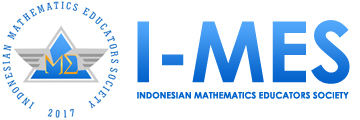How do junior high school students solve proportional reasoning problems?
DOI:
https://doi.org/10.29408/jel.v11i2.27922Keywords:
junior high school strategies, proportional reasoning problems, ratio and proportionAbstract
Proportional reasoning is a crucial skill that students need to master to achieve success in learning mathematics at both the elementary and secondary levels. This study aimed to identify the strategies junior high school students used when solving proportional reasoning problems related to ratios and proportions. This qualitative descriptive research was conducted on six seventh-grade students at a junior high school in Belitang, selected through purposive sampling. Data was collected using tests and interviews and analyzed descriptively. Data validity was ensured through triangulation techniques. The findings revealed that students with low abilities used a repeated addition strategy to solve proportional reasoning problems. Meanwhile, students with medium abilities employed the multiplication strategy but occasionally made errors using the additive strategy—students with high abilities predominantly used multiplicative strategies. The study suggests that students with medium abilities do not consistently apply proper proportional reasoning strategies, highlighting a need for further research into their solution approaches. In addition, it is essential to design learning activities that specifically target the improvement of proportional reasoning skills for students with lower abilities, given the critical role this skill plays in mathematics education at both the primary and secondary levels.
References
Anat, K., Einav, K., & Shirley, R. (2019). Development of mathematics trainee teachers ’ knowledge while creating a MOOC. International Journal of Mathematical Education in Science and Technology, 1–15. https://doi.org/10.1080/0020739X.2019.1688402
Arican, M. (2018). Preservice mathematics teachers’ understanding of and abilities to differentiate proportional relationships from nonproportional relationships. International Journal of Science and Mathematics Education. https://doi.org/10.1007/s10763-018-9931-x
Arican, M. (2019). A diagnostic assessment to middle school students’ proportional reasoning. Turkish Journal of Education, 8(4), 237–257. https://doi.org/10.19128/turje.522839
Ayan, R., Isiksal-bostan, M., & Stephan, M. (2019). A math teacher’s participation in a classroom design research : teaching of ratio and proportion. Eleventh Congress of the European Society for Re- Search in Mathematics Education.
Cansız Aktaş, M. (2022). A comparison of solution strategies for proportional and non- proportional problems of students at different education levels: a cross-sectional study. International Journal of Education Technology and Scientific Researches, 7(18), 1064-.
Chaim, B. D., Keret, Y., & Ilany, B.-S. (2012). Ratio and proportion research and teaching in mathematics teachers’ education (pre- and in-service mathematics teachers of elementary and middle school classes). Sense Publishers.
Cox, S. K., & Root, J. R. (2020). Modified schema-based instruction to develop flexible mathematics problem-solving strategies for students with autism spectrum disorder. Remedial and Special Education, 41(3), 139–151. https://doi.org/10.1177/0741932518792660
Dougherty, B., Bryant, D. P., Bryant, B. R., & Shin, M. (2017). Helping students with mathematics difficulties understand ratios and proportions. TEACHING Exceptional Children, 49(2). https://exceptionalchildren.org/journal/helping-students-mathematics-difficulties-understand-ratios-and-proportions
Fauzi, F. A., Ratnaningsih, N., & Nimah, K. (2020). Analisis kemampuan berpikir kritis matematis peserta didik ditinjau dari gaya berpikir Gregorc [Analysis of students' mathematical critical thinking skills based on Gregorc's thinking style]. Journal of Authentic Research on Mathematics Education (JARME), 2(2), 96–107. http://jurnal.unsil.ac.id/index.php/jarme/article/view/1734
I, J. Y., Martinez, R., & Dougherty, B. (2018). Misconceptions on part-part-whole proportional relationships using proportional division problems. Investigations in Mathematics Learning, 00(00), 1–15. https://doi.org/10.1080/19477503.2018.1548222
Im, S.-, & Jitendra, A. K. (2020). Analysis of proportional reasoning and misconceptions among students with mathematical learning disabilities. Journal of Mathematical Behavior, 57(August 2019). https://doi.org/10.1016/j.jmathb.2019.100753
Izzatin, M. (2020). Proportional reasoning in mathematics: what and how is the process? Proceedings of the 2nd International Conference on Innovation in Education and Pedagogy (ICIEP 2020), 619(ICIEP 2020), 115–119. https://doi.org/10.2991/assehr.k.211219.022
Johar, R., Yusniarti, S., & Saminan. (2018). The analysis of proportional reasoning problem in the indonesian mathematics textbook for the junior high school. Journal on Mathematics Education, 9(1), 55–68. https://ejournal.unsri.ac.id/index.php/jme/article/view/4145
Khotimi, A. Z., Prabawanto, S., & Jupri, A. (2024). How high school students solve proportional reasoning problem ? Jurnal Didaktik Matematika, 11(1), 41–58. https://doi.org/10.24815/jdm.v11i1.36458
Lamon, S. (2007). Rational numbers and proportional reasoning: Toward a theoretical framework for research (In K. Lest). Second handbook of research on mathematics teaching and learning (pp. 629–667). Information Age Publishing.
Lamon, S. (2012). Teaching fractions and ratios for understanding: Essential content knowledge and instructional strategies for teachers (Lamon, S.).
Lamon, S. (2020). Teaching fractions and ratios for understanding. In teaching fractions and ratios for understanding (4th ed.). In Routledge. https://doi.org/10.4324/9781003008057
Langrall, C. W., & Swafford, J. (2000). Three balloons for two dollars: developing proportional reasoning. Mathematics Teaching in the Middle School, 254–261.
Muttaqin, H., Putri, R. I. I., & Somakim. (2017). Design research on ratio and proportion learning by using ratio table and graph with OKU Timur context at the 7 th grade. Journal on Mathematics Education, 8(2), 211–222. https://doi.org/10.22342/jme.8.2.3969.211-222
Nugraha, Y., Sujadi, I., & Pangadi, P. (2016). Penalaran proporsional siswa kelas VII [Proportional reasoning of seventh grade students]. Beta Jurnal Tadris Matematika, 9(1), 34. https://doi.org/10.20414/betajtm.v9i1.2
Nur, I. M., & Sari, D. P. (2022). Penalaran proporsional siswa SMP dalam menyelesaikan masalah missing value dan comparison berdasarkan gaya kognitif sistematis [Proportional reasoning of junior high school students in solving missing value and comparison problems based on systematic cognitive style]. Jurnal Ilmiah Wahana Pendidikan, 8(November), 467–482. https://jurnal.peneliti.net/index.php/JIWP/article/view/2831
Oktaviani, M. (2019). Innovation in learning proportion using proportion table. JISAE: Journal of Indonesian Student Assessment and Evaluation, 5(2), 37–42. https://doi.org/10.21009/jisae.v5i2.12568
Prayitno, A., Rossa, A., & Widayanti, F. D. (2019). Level penalaran proporsional siswa dalam memecahkan missing value problem. Jurnal Riset Pendidikan Matematika, 6(2), 177–187. https://doi.org/10.21831/jrpm.v6i2.19728
Sari, Y. M., Fiangga, S., El Milla, Y. I., & Puspaningtyas, N. D. (2023). Exploring students’ proportional reasoning in solving guided-unguided area conservation problem: A case of Indonesian students. Journal on Mathematics Education, 14(2), 375–394. https://doi.org/10.22342/JME.V14I2.PP375-394
Sugiarni, R., Herman, T., Suryadi, D., & Prabawanto, S. (2024). How do pre-service mathematics teachers resolve proportion tasks? Focus strategy of proportion solving. Beta: Jurnal Tadris Matematika, 17(1), 10–33. https://doi.org/10.20414/betajtm.v17i1.619
Taufik, A. (2021). Kemampuan penalaran proporsional matematis siswa dengan gaya belajar field independent [Mathematical proportional reasoning ability of students with field independent learning styles]. Jurnal Edukasi dan Sains Matematika (JES-MAT), 7(2), 85–100. https://doi.org/10.25134/jes-mat.v7i2.4213
Tunç, M. P., & Çakıroğlu, E. (2020). Fostering prospective mathematics teachers’ proportional reasoning through a practice-based instruction. International Journal of Mathematical Education in Science and Technology. https://doi.org/10.1080/0020739X.2020.1844909
Utari, R. S., Putri, R. I. I., & Hartono, Y. (2015). Supporting 7 th students’ proportional reasoning using palembang culture as context and ratio table as model. The Third South East Asia Design/Development Research International Conference, 344–352.
Wahyuni, I. (2022). Penalaran Proporsional [Proportional Reasoning]. Lembaga Ladang Kata.
Weiland, T., Orrill, C. H., Nagar, G. G., Brown, R. E., & Burke, J. (2021). Framing a robust understanding of proportional reasoning for teachers. Journal of Mathematics Teacher Education, 24(2), 179–202. https://doi.org/10.1007/s10857-019-09453-0
Downloads
Published
How to Cite
Issue
Section
License
Copyright (c) 2025 Filian Yunita Sari, Zulkardi, Ratu Ilma Indra Putri, Ely Susanti

This work is licensed under a Creative Commons Attribution-ShareAlike 4.0 International License.
Authors who publish with the Jurnal Elemen agree to the following terms:
- Authors retain copyright and grant the journal right of first publication with the work simultaneously licensed under Creative Commons Attribution-ShareAlike 4.0 International License (CC BY-SA 4.0).
- Authors are able to enter into separate, additional contractual arrangements for the distribution of the journal's published version of the work (e.g., post it to an institutional repository or publish it in a book), with an acknowledgment of its initial publication in this journal.
- Authors are permitted and encouraged to post their work online (e.g., in institutional repositories or on their website) prior to and during the submission process, as it can lead to productive exchanges, as well as earlier and greater citation of published work.
Jurnal Elemen is licensed under a Creative Commons Attribution-ShareAlike 4.0 International License





